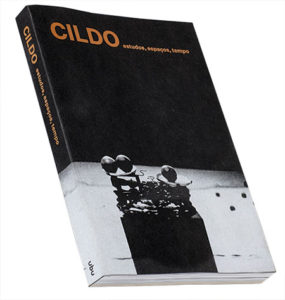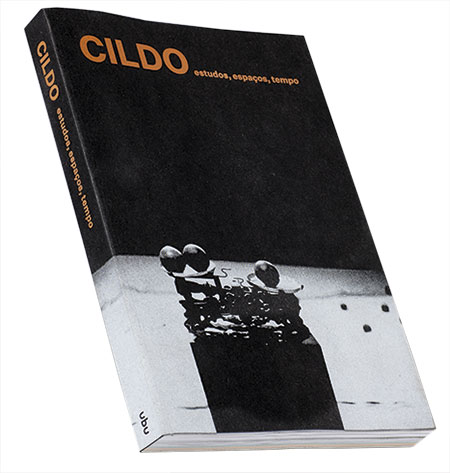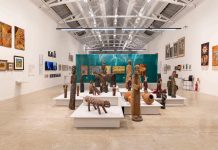*Por Tiago Mesquita
O livro Cildo – estudos, espaços, tempo, lançado pela Ubu Editora, retrata a trajetória de Cildo Meireles a partir de seus procedimentos. Os organizadores Diego Matos e Guilherme Wisnik reuniram cerca de quarenta trabalhos, realizados ao longo de cinquenta anos de carreira. As obras são apresentadas por meio de fotografias de exposição, notas do artista, desenhos e projetos. Conhecemos como os trabalhos vieram a público, mas também os passos de elaboração de Cildo Meireles e parte de sua repercussão crítica.

Os vestígios nos ajudam a reconstruir os passos da obra. Acompanhamos as metamorfoses de alguns trabalhos importantes ao longo do tempo e entender a forma que eles assumem em diferentes fases: idealização, desenho, implementação e uso. A documentação veio do arquivo do próprio artista e é arrumada em ordem cronológica.
A relação dos trabalhos no livro nos faz pensar uma relação entre as ideias do que veio antes e o que veio depois. O livro é completado por uma excelente fortuna crítica que explora a interlocução da obra com a história da arte brasileira e estrangeira, a relação com diversas formas teóricas e os sentidos que a obra ganhou quando escapou da mão do seu autor.
O livro estuda as variações de algumas ideias e o sentido que elas ganham em diferentes formas de implementação inclusive. Por isso, os trabalhos mostrados não possuem nem uma técnica definida, tampouco pedem do espectador uma forma de atenção convencional. Talvez por isso trabalhos mais objetuais, como Ouro e paus, Estojos de geometria, Árvore de dinheiro, que pedem uma forma de contemplação mais tradicional, tenham ficado de fora da narrativa do livro.
A noção de estudo organiza a obra. O estudo seria um refinamento dos enigmas que colocam as convicções ideológicas em xeque. Seria um teste dessas percepções. Assim, faz lembrar o experimento científico, o teste de hipóteses.

Guy Brett, em um texto de 2005, republicado no livro, afirma que a produção brasileira da geração imediatamente anterior a Cildo Meireles confiou nos sentidos. Essa investigação da percepção foi uma maneira de encarar os limites de uma racionalidade burocrática. A arte devia se haver com esses limites e buscar uma nova relação com a vida.
Artistas como Lygia Clark e Hélio Oiticica se distanciam da contemplação racionalista tradicional para criar relações entre sentidos que estavam aparentemente desconectados. Assim, criaram situações ou ambientes, em que essas formas sensuais de perceber funcionam em alta voltagem. Corpo e mente, razão e sensibilidade, até mesmo as formas de convívio seriam refeitas por essas relações mais diretas e comunitárias. Essa promessa escapista, romântica e sensorial, não parece estar diante de Cildo quando ele começa os seus primeiros trabalhos.
O artista vem da geração batizada por Frederico Morais de “geração AI-5”. As promessas de modernização e a construção de uma percepção utópica não estavam no horizonte. As sensações em seu trabalho, daí em diante, se tornam espaço para a dúvida. Como aprendemos com o texto de Frederico, a experiência sensorial é colocada em dúvida. Assim, a aparência das esferas na instalação de Eureka/Blindhotland (1970-1975) é desmentida pelo seu peso e os sons amplificam o que Sônia Salzstein nomeia como confusão dos sentidos.

Por isso, o espaço dos primeiros trabalhos de Cildo, os Espaços Virtuais: Cantos (1967-8), não é expansivo. Ele se parece como um beco sem saída. O colorido de Desvio para vermelho (1967 – 84) não potencializa a percepção para além dos limites da racionalidade: o vermelho torna os objetos homogêneos. As experiências são negativas, de se procurar algo pelas sensações, pelos instrumentos da razão e não encontrar. O estudo parece esgotar esses saberes, em um exercício cético permanente da dúvida.
Cildo Meireles é provavelmente um dos artistas contemporâneos que mais influenciou a arte contemporânea engajada, à sua revelia. Diferente de muitos que usam a arte como veículo de convicções, mas é crítica ideológica, a crítica da maneira como pensamos quando acreditamos não pensar. A sua força política é a radicalização da incerteza e a indefinição. Esse livro nos traz a força da dúvida radical.
*Tiago Mesquita é graduado em Ciências Sociais e é mestre em Filosofia pela Universidade de São Paulo. Atua como professor de História da Arte na FIAM-FAAM e escreve críticas para diversos veículos de comunicação. Seu trabalho tem ênfase em arte contemporânea, arte brasileira, arte moderna, crítica de arte e pintura
The metamorphoses of the artist’s work
The theme that comes out of the work made by Cildo Meireles reveals a good key of his history
By Tiago Mesquita
The book Cildo – estudos, espaços, tempo (Cildo – studies, spaces, time), released by Ubu Editora, portrays the trajectory of Cildo Meireles based on his procedures. The organizers Diego Matos and Guilherme Wisnik gathered about forty works, made over fifty years of his career. The works are shown through exhibition photographs, artist’s notes, drawings and projects. We are presented to how the works came to the public, but also to the steps of Cildo Meireles’ elaboration and part of his critical repercussion.
The traces help us rebuild the steps of his work. We follow the metamorphosis of some important pieces over time and understand the form they take in different phases: idealization, design, implementation and use. The documentation came from the artist’s own file and it is arranged in chronological order.
The relation of the works in the book makes us think a connection between the ideas of what came before and what came later. The book is finished by excellent critical essays that explore the interlocution of the artwork with the history of Brazilian and foreign art, the relationship with various theoretical forms and the meanings that the work gained when it escaped the hand of its author.
The book studies the variations of some ideas and the sense they gain in different forms of implementation. Therefore, the works shown do not have a definite technique, nor do they ask the spectator for a conventional form of attention. Perhaps that is why more objectual works, such as Diamond and Clubs (Ouro e Paus), Geometry Cases (Estojos de Geometria), Money Tree (Árvore do Dinheiro), which call for a more traditional form of contemplation, have been left out of the narrative in the book.
The notion of study organizes the work. The study would be a refinement of the puzzles that question ideological convictions. It would be a test for these perceptions. Thus, it reminds one of the scientific experiment, the test of hypotheses.
Guy Brett, in a text written in 2005, republished in the book, states that the Brazilian production by the generation before Cildo Meireles relied on the senses. This investigation of perception was a way of looking at the limits of bureaucratic rationality. Art must take these limits and seek a new relationship with life.
Artists like Lygia Clark and Helio Oiticica distance themselves from traditional rationalist contemplation to create relationships between senses that were apparently disconnected. Thus, they have created situations or environments in which these sensuous ways of perceiving the works in high voltage. Body and mind, reason and sensibility, even the forms of conviviality would be remade by these more direct and communal relations. This escapist promise, romantic and sensory, does not seem to be before Cildo when he begins his first works.
The artist comes from the generation baptized by Frederico Morais as “AI-5 generation”. The promises of modernization and the construction of a utopian perception were not on the horizon. The sensations in his work, thereafter, become room for doubt. As we learn from the text of Frederico Morais, the sensory experience is called into question. Therefore, the appearance of the spheres in Eureka/Blindhotland installation (1970-1975) is denied by their weight and the sounds amplify what Sônia Salzstein names as confusion of the senses.
For this reason, the space of Cildo’s early works, Virtual Spaces: Cantos (1967-68), is not expansive. It looks like a dead end. The colouring of Deviance for Red (1967-84) does not enhance perception beyond the limits of rationality: red makes objects homogeneous. The experiences are negative, to look for something by sensations, by the instruments of reason and not find what is desired. The study seems to exhaust these knowledge, in a permanent skeptical exercise of doubt.
Cildo Meireles is problably one of the contemporary artists who most influenced the current art commited to a cause, behind his back. Unlike many others that use art as a vehicle for convictions, but it is an ideological criticism, the criticism on how we think when we believe we are not thinking. His political force is the radicalisation of the incertitude and the indetermination. This book brings us the force of the radical doubt.








